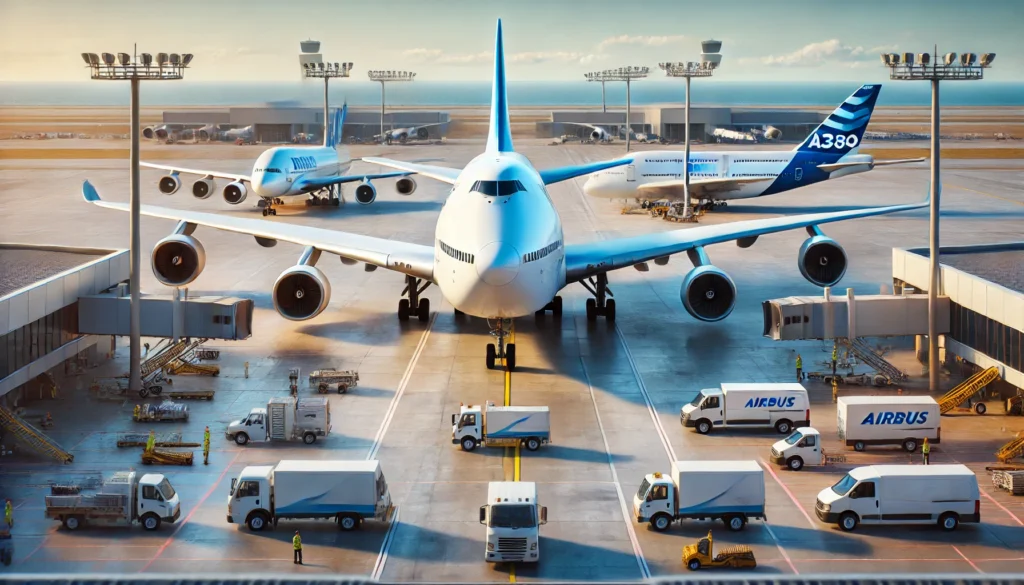Airbus or Boeing? The Jet Showdown that Redefines Air Travel When it comes to the skies, two titans dominate the landscape of wide-body Aircrafts: Airbus and Boeing.
Each represents decades of innovation, engineering excellence, and a relentless pursuit of perfection in aviation. But as travelers increasingly prioritize performance, comfort, and efficiency during their journeys, a compelling question arises: which manufacturer truly reigns supreme?
In this blog post, we’ll dive into an exhilarating head-to-head evaluation that unravels the intricacies of these aviation giants. Buckle up as we explore how each aircraft stacks up against its competitor—delving into everything from fuel efficiency and cabin amenities to technology advancements and environmental impact.
Whether you’re a frequent flyer or an aviation enthusiast, join us on this journey to discover which brand will soar above the rest!
Introduction to Wide-Body Aircraft and Their Importance in Commercial Aviation
The foundation of commercial aviation relies greatly on the rising significance of wide-bodied jets Furthermore, the minute you sit on a wide-bodied airliner, you aren’t merely getting on board a plane, but rather, the entire paradigm shift surrounding air travel.
These engineering masterpieces, also known as jumbo jets have the capacity of transporting hundreds of people across the globe and have been strategically built with long, endurance travel in mind.
With the need for more comfort and efficiency in flights, travelers can notice the increasing dominance of Airbus and Boeing and their impressive fleets.
But one stands out from the other – why? With some of the biggest passenger planes in the world, both companies make it hard to determine which one comes out on top. Are you looking for a fast ride, or do you want some space? Efficiency over amenities?
Let’s take a closer look at how these two juggernaut’s compare on performance that is critical to the traveler – you. Fasten your seatbelt for an enlightening ride through the world of commercial aviation giants.
History and Overview of Airbus and Boeing
Airbus and Boeing are two of the foremost giants in aviation, with a significant history for each that has contributed to air travel as we now know it.
Boeing was established in 1916 in Seattle, Washington, where it rose to prominence during World War II with its production of military aircraft. The introduction of the Boeing 707 in the late 1950s changed air travel forever, heralding the comforting speed of the jet age.
Established in 1970, Airbus entered as a competitor to Boeing and saw major success with the A300, which was one of the first wide-body aircraft.
Both have expanded into multinational corporations, and continuously improve their offering across the entire commercial aviation spectrum. Today, both companies offer a wide variety of jumbo jets to suit the different needs of airlines across the globe.
Performance Comparison: Speed, Range, Capacity, and Fuel Efficiency
There is almost none as fierce as the competition between Airbus and Boeing. Time is a critical asset for airlines, and the speed of a jet is arguably the most important factor. For the A350 and the 787 cruise speed is close to their respective Mach numbers of -.85 and -8.
Boeing leads with the 777-200LR and its carrying range of over 15,000 kilometers, but the A350 XWB is no slouch either, boasting its comparable distance abilities.
Fuel efficiency remains a relevant issue as airlines pursue the reduction of emissions and operational costs. Each manufacturer is working on lighter materials and more advanced aerodynamics, but they differ in engine designs which account for a lot of fuel consumption during flight.
Comfort Comparison: Cabin Space, Seat Configuration, In-Flight Amenities
When it comes to wide-body aircraft comfort, both the Airbus and Boeing offer competing options. Cabin space is a very controversial topic as each manufacturer has its unique set of designs intended for different types of passenger experience which undergo modeling in different aircraft.
Airbus claims that passengers in its A350 series enjoy more space in the cabin which facilitates greater freedom of movement. At the same time, this feature impacts the quality of long-haul flights. On the other hand, Boeing’s 787 Dreamliner has better overall passenger comfort due to advanced lighting features and higher humidity levels in the cabin.
Seat layout is also critically important. Airlines can choose from a number of layouts based on the exact market they wish to target. An example would be an A380 geared towards economy passengers. They will appreciate the seat configuration because it is remarkably spacious.
In the case of these jumbo jets, the difference is made by the in-flight services. Certain airlines have luxurious lounges in the A380 whereas others place more focus on offering high-quality gourmet meals in the 777X or state-of-the-art entertainment equipment. Therefore, all such choices play a role in how comfortable passengers perceive their trip to be.
Operational Costs and Efficiency Analysis: Maintenance, Training, Operating Expenses
With respect to operational costs and to wide-body aircraft, maintenance cost is perhaps most critical. Both Airbus and Boeing have designated amounts for their jumbo jet’s operational availability. While routine checks are expensive, the trust every brand comes with sometimes gets incorporated in these costs.
There is also an additional burden for crew member’s training. Airlines need to spend a lot on the instructors for every pilot’s training program for each model’s system and features which affects the choice of Boeing or Airbus for a particular airline as they consider a long term financial projections.
Operating expenses include fuel, airport, and service fees. Reducing the cost of fueling an airplane is also important; both manufacturers seek new technology that would lessen that cost for the airlines.
Often the right wide body selection is based on the summation of all those factors against the expected outcomes. The combination of those decisions has an effect on the financial results and the quality of the passengers’ experiences with those large flying vehicles.
Customer Satisfaction and User Experience: Airline Reviews and Passengers’ Feedback
For the largest passenger airliners, it is the customer satisfaction that matters most. Normally, the users will comment on the internet with the aspects of the comfort and service.
User reviews of wide-body airlines provide insight into the overall experience of passengers on vessels such as the Airbus A380 or the Boeing 787 Dreamliner. Airlines have noticed that cabin space is greatly appreciated by travelers, particularly on long hauls as pleasant seating can ease the journey.
The quality of in-flight goods are equally important. For comments and feedback, the most recurrent topics are Wi-Fi, entertainment options, as well as meal quality. Higher reviews are usually given to airlines that focus on these areas.
Nonetheless, not every experience is pleasurable. The negative side is that some passengers have taken issue with delays and confinement on certain routes. They pay a substantial amount for their tickets, and it is vital for airlines to address these issues and improve their services accordingly.
In the long haul, airlines’ reputations revolve greatly around their choice of jumbo jets. For instance, frequent travelers actively promote certain airlines with a good track record of offering quality services while others are shunned due to poor experiences.
Sustainability Considerations: Environmental Impact and Emissions Reduction Efforts
Air travel is an industry that tends to come under scrutiny for its environmental footprint, and as eco-friendliness becomes more commonplace, there are many initiatives airlines need to capture the attention of potential customers. Both Airbus and Boeing have to improve their ignorance in sustainability.
With added innovation comes extra focus on emission lowering. Planes such as the Boeing 787 Dreamliner has made use of lighter materials leading to better fuel efficiency. Furthermore, its new engines boast much lower CO2 emissions when compared to older models.
With the A350 Excel XWB, Airbus is demonstrating it is not new to the game of advanced aircraft engineering. The company’s commitment to sustainable aviation fuels (SAFs) also shows an initiative towards more green business operations.
These manufacturers are equally looking into developing electric and hybrid solutions. This could change the way air travel is viewed in terms of its impact on the climate.
Passengers are now paying more attention to airlines that guarantee sustainability and good public image. Airlines owning this type of wide-bodied jets are in a good position as they can attract responsible travelers from all parts of the world.
Future Outlook: Upcoming Developments and Innovations from Airbus and Boeing
Aerodynamic advancement and encountering aerospace challenges head on is the motto for both Airbus and Boeing. Both companies are heavily investing in new designs that will improve efficiency and eco-friendliness of the aircrafts.
Airbus began the development of the A350 Excel XWB with the expectation that it will provide increased fuel savings due to more efficient aircraft shapes and use of composite materials. Innovative manufacturing methods such as 3D printing are also changing how things are done in the company; they simplify production processes.
At Boeing’s, the upcoming 777X series are intended to change the way the world thinks of air travel. They are new generation wide-bodied airplanes with bigger windows, quieter engines, and higher lift-to-drag ratio wings that can better fuel.
Both manufacturers are looking into Sustainable Aviation Fuels (SAFs) to help achieve net-zero carbon emissions. The future of wide-bodies looks bright with new technologies like electric propulsion systems coming into play.
Comfort for passengers will also improve as smart cabin functionalities further enhance the experience in wide-body aircraft from the two superpowers.
Final Verdict: Which One Reigns Supreme?
When choosing between Airbus and Boeing, things are not as simple. Each manufacturer has a strong portfolio of wide-body aircraft which satisfies different airline requirements and tastes of the passengers.
Airbus has gained wider visibility with its A380 model, which is considered one of the biggest passenger aircraft. It tends to focus on space in the cabin and new technologies, and so is appealing to airlines who need comfort and capacity at the same time.
As for Boeing, its fuel-efficient long-range 777 series is far more popular. These jets are operationally dependable and have lower maintenance costs, making them favorites among the airlines. Another claimant for this title is the 787 Dreamliner with its advanced materials aimed at weight reduction and increased performance.
Performance metrics which include speed, range, capacity, and fuel efficiency, are fundamental for any airline’s fleet operations. In addition, comfort cannot be ignored as ample cabin space and good seat arrangements matter a lot for long haul flights.

